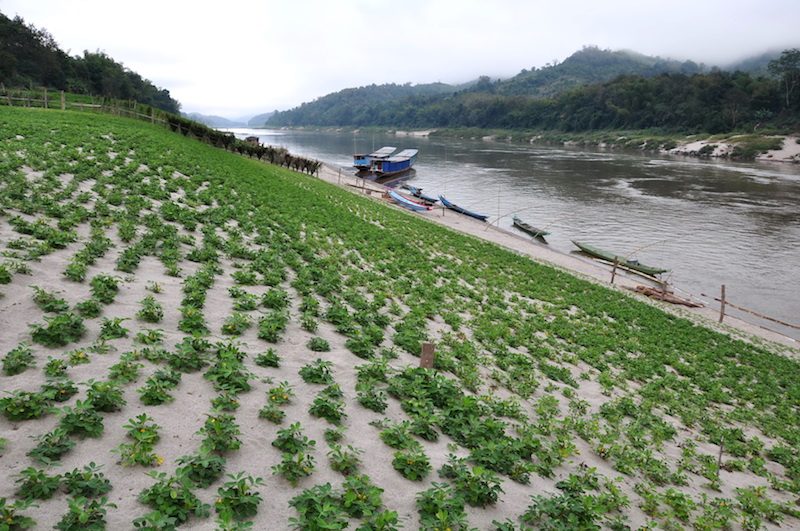In a press statement quietly posted to its website earlier this week, the Mekong River Commission (MRC) made note of an update recently received from the Laotian government.
A third Mekong hydropower project—in Pak Beng, northern Laos—is now officially moving forward, bringing a massive, 912-megawatt project into a river that is second only to the Amazon in its level of biodiversity, and upon which the livelihoods of millions depend.

The notification sent the wheels of the MRC, the body responsible for advising regional governments on the social and environmental impacts of such projects, sputtering once more into motion. The press release heralded the start of another “prior consultation” process—the third the commission has conducted—to evaluate how Pak Beng will affect the lives of fishermen and villagers downstream and, theoretically, to give weight to their concerns.
But with the wounds of two previous projects still fresh in the memories of advocacy groups and Mekong basin inhabitants, many are questioning why the commission, whose mandate is to enforce a 1995 sustainable development agreement, still exists at all.
“The MRC—well, one area where it has been strong is in putting out studies to improve knowledge about the Mekong,” said Maureen Harris, the Southeast Asia program director for International Rivers, a U.S.-based NGO.
“What they haven’t been effective in is ensuring this information makes its way into decisions” made by the governments it works with, she said.
The prior consultation process on both of the previous Mekong dams in Laos—Don Sahong and Xayaburi—was patchy and ignored crucial information, Ms. Harris said. The impact assessments, she added, focused on upstream reservoirs and involved almost no consideration of how the projects would affect those who lived downstream.
The perceived failure of the Laotian government to take into account the livelihoods of those living beneath Don Sahong and Xayaburi has sparked a lawsuit and dozens of demonstrations led by environmental groups in other countries.
What remains to be seen, as the projects continue inexorably forward, is what will finally become of the thousands of people living downstream. Floods and mass fish deaths are forecasted; several have already occurred.
Downstream effects aside, Ms. Harris said, none of the MRC’s prior consultation procedures have taken into account the cumulative effects of building a “cascade” of dams on the river—like the 11 currently proposed in Laos and Cambodia, of which Pak Beng is one.
Rather, the effects of each dam are considered in isolation.
“These cumulative effects are very severe,” Ms. Harris said, adding that the environmental toll of a cascade of dams, according to the MRC’s own research, has been shown to be significantly worse than that of just one or two. “The loss of fisheries will be some 42 percent.”
For nations like Laos and Cambodia, where fish are the main source of protein for millions and malnutrition contributes to stunted spinal growth and slow brain development in childhood, the toll of the dams has been severe, and will only escalate with the construction of Pak Beng.
Meanith Mean, of the northern Cambodia-based NGO 3SPN, was unequivocal. “Our fish will not be able to migrate. We are extremely worried—all civil society organizations, all the people.”
As for the MRC’s prior consultation process, he said, “They are playing a game. The MRC is a show. They do nothing.”
Ian Thomas, former drought adviser for the commission, was inclined to agree.
“It’s a ghost; it’s almost dead; it’s a zombie,” he said of the commission.
“I don’t think the MRC will exist much longer,” he added, saying that he doubted donors would continue to fund an organization that clearly had no clout with regional powers.
“They run on a skeleton staff. They’ve proved how ineffective they are. Countries won’t continue giving money.”
However, in a press release in late September, the MRC said it had received $2.8 million from the German government to be dedicated to “sustainable hydropower” projects. Meanwhile, during an August meeting discussing the MRC budget, the E.U. and other donors expressed their continued commitment to the organization, transferring millions of dollars of financial support to a “basket fund” to be used at the organization’s discretion.
“We like the basket fund. It gives you accountability,” Jerome Pons, of the E.U. delegation, told those at the meeting, emphasizing that the E.U. had a good understanding of the regional governments and their priorities.
When pressed on Don Sahong and Xayaburi after the meeting, Mr. Pons said, “The mandate of the MRC is a technical knowledge hub. It is about sharing information and allowing member countries to make the decisions they will make.”
Ms. Harris and others disagreed. The MRC’s role, said Ms. Harris, was to guarantee the Mekong Agreement, a 1995 sustainable development agreement “which goes far beyond providing technical information.”
The MRC secretariat could not be reached over the past two days, while various staff members for the commission declined to comment.